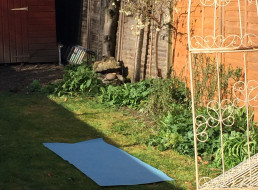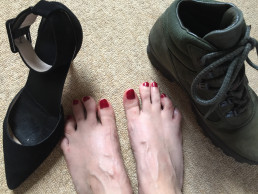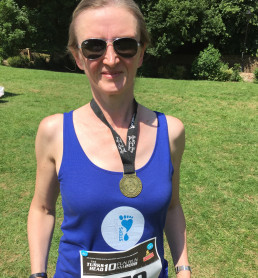Diff-ability & Me: when someone else says what’s in my head!
Did you watch Alex Brooker: Disability and Me on BBC iPlayer? I caught it last weekend and I’m so glad that I did. I have rarely watched anything about disability that I could fully identify with. But this was like someone being inside my head and knowing what I feel.
This programme gives you a good understanding of what being different feels like - and how easy it is, when you’re born with a disability, not to actually know that much about it or have really considered its impact on who you are.
I can’t possibly share everything about this programme in a blog post. Nor should I, when the best advice I can give is to watch it here. But it’s inspired me to talk about how I relate to what he shared about being different.
1. It’s a personal journey and we’re all differently disabled
I had not met any adults (that I knew of) with hip dysplasia until I started this blog and joined the Steps Charity facebook group. What strikes me in those forums is how different the challenges are that people face, who all have the same condition. Many other ‘hippies’ who read my blog could not envisage walking the South Downs Way. Others do a whole host of physical activities I couldn’t comprehend.
I loved that Alex started and ended this documentary by simply saying he wasn’t trying to be the voice of all disabled people, he was just one person trying to learn more about himself, his own disability, and how it impacts him. I started walking and blogging for exactly the same reason.
2. It’s very possible to know very little about your own condition
Watching Alex tell his Mum to come into the doctor’s appointment with him because she knows more about “his challenges and what-not”, made me feel a whole lot better about my own lack of knowledge about hip dysplasia. For the first three blogs I wrote, I even think I’d mis-spelled it!
I grew up knowing I was differently-abled and knew the term CDH, but for the first 16 years of my life, the doctors all spoke to my parents, not me, about my condition. I loved visiting Sheffield Children’s Hospital for check-ups because they had new toys and other kids there had funny legs that looked like mine. But I couldn’t possibly comprehend the discussions and decisions being taken. I remember having more curiosity when I had my leg lengthened aged 16 – and in the end watching the surgical teaching video of the operation beforehand – but it was my parents, not me, signing the consent form.
The first time I became conscious of how little I knew about my own body and history was when, aged 32, I went to the first consultation about my hip replacement. Mum and Dad weren’t there. Suddenly I was discussing the options, making the decisions and signing the consent form complete with the list of all the things that could go wrong. I suddenly understood the emotional impact that this must have had on my parents. As Alex did with his mum on their return visit to Gt. Ormond Street.
3. Being a diff-abled teenager is hard
Both Alex and those he interviewed who’d been born with their disability, said that they had the hardest time as a teenager. And boy do I remember that!
Paralympic swimmer Susie Rodgers shares with Alex how she even stopped swimming for a while, because at that age you become hyper-conscious of how your body looks and you don’t want people staring.
Whilst other girls’ legs were becoming beautiful, shapely assets, mine remained spindly and not straight right through school. Aged 13, I actually won a knobbly knee contest at the local working mens club! My DDH bum is flat as a pancake and there are no curvy child-bearing hips. As far as my lower body is concerned, none of the assets that attracted boys were there. Definite wallflower territory!
Being really physically different is not the same as choosing to stand out by dying your hair blue. There’s this extra layer in trying to decide what your identity is – where does the disability fit in? How much do I want it to define me? Do I want to hide it (quite hard) or share it? Do I try and prove I can do anything others can, or do I protect myself from situations where I might be physically challenged? I do both, for the record!
4. Unspoken fears for the future
The part in his documentary where Alex gets most emotional is when he admits for the first time that he fears how his young children’s reaction to his disability might change as they get older. What will they think when I can’t do what the other dads can? He also shares how hard it is to watch doctors check his new-born’s arms and legs to check they’re "not like his".
I never had children. I was clear from a young age that I didn’t want to. Part of that decision was very definitely about my hip-dysplasia. I remember discussions with doctors and my dad about whether I could biologically have children and of course the answer was 'as much as anyone else'. But try and have them before a hip replacement. And obviously with your particularly bad hips and part of your pelvis missing, you might find it harder to carry the weight or have a natural birth.
I’m sure all of that had an impact on my decision. And I also recognise not wanting to be a parent who can’t do what the other mums can. Carrying any weight is no fun for me. I’m so grateful for Tesco deliveries because food shopping used to be a nightmare. The thought of lifting a toddler, then trying to walk and not fall over and injure my child, was always in my mind. In the end I figured that just myself was enough to look after and keep upright.
And the final fear is what will happen to my joints when I get older? When I was 16 I was informed that it was the norm to have no more than two hip replacements, each would last 10-15 years and then that would be it. In my young head that had me in a wheelchair by mid-40s. That fear drove me to seek to achieve more and more, quicker and quicker - like a ticking clock to get everything done before I can't walk any more. I still sometimes think “when do we need to move into a bungalow so I’m prepared for the day the stairs are too much trouble?”
Of course, having watched elderly parents, or just friends who used to be runners then injured their knees, I can see that this isn’t a disability issue but more of an ageing issue for everyone. It’s just instead of starting to think about it in mid-life, I’ve been thinking about it since I was 16.
5. Superhumans struggle with real life too
As a marketer I find the way disabled people are portrayed both fascinating and frustrating. Most often you are presented with people who are either severely immobile and housebound or the SuperHuman Paralympian. Very little in-between. The Paralympics in 2012 was fundamental in its representation of Ability not Dis-ability and I’m so glad I got a ticket to cheer the Paralympic athletes at the Olympic stadium. But it’s as hard to live up to being a SuperHuman as it is for most Sunday runners to compare themselves with Mo Farrah!
So it was brilliant to hear Susie Rodgers tell Alex she still finds it annoying that she can’t do some things and how that does not feel at all super-human. In reality she is super-human at one thing - swimming.
I still can’t push a shopping trolley without ramming people (you use your hips to steer); it’s really hard to cut my toe-nails or tie shoe laces; I have a minor panic attack if I have to walk upstairs when the handrail is on the left not the right, or game-over if I also have a bag to carry up the stairs. And yet I walked the South Downs Way which inspired myself and others.
Thank you - to You and to Alex Brooker
First off, thanks for reading this. It turned out to be a long one!
I was just so inspired to write this because of Alex’s documentary. So a huge thanks to him too for sharing the normality of being different. If you get an hour, do go and watch it here.
And if you want to follow my walking challenges follow @WalkingJill on Facebook here or click here to donate and support Steps Charity.
Until the next time…. Love to you all xx
The 'Wonky Dog'. Yoga and hip dysplasia.
So I got up this morning and decided that I was definitely going to seize up if I didn't take action to get more exercise during the collective lockdown. For the last few days I have gone out for a daily walk - at safe distance - but my body is so used to its morning swim, and monthly osteo visit, that it's starting to really object. The swimming pool has always been the one place where my body doesn't feel lopsided, and it totally relaxes. Rather than feeling like exercise it feels like giving my brain and my muscles a rest. Like everyone I've got to find a new way of doing things when what we would normally do isn't an option for very good reason.
My drawings for a pop-up olympic pool in our back garden quickly proved that I was missing most of what I needed - the space, the materials, the ability to build anything. And so I turned to my dusty yoga mat. I used to attend yoga classes in my late 20s and through my 30s, but have got out of practice in favour of swimming.
I remember my first ever Yoga class. Well actually I tried Pilates first but when I couldn't complete any of the warm up exercises I felt too awkward to return. But for some reason, in the Yoga class I could at least do something approximating the poses. And the class teacher was happy to let me get close to poses or do alternatives rather than try and push me into a pose.
And so my sun salutations this morning were my own 'hippy' version. And it was just what I needed. Achieving perfect balance between left and right when the two sides of my body aren't built the same would be a futile exercise. And so I work each side of my body as it needs, and I just skip the bits that aren't possible. The point is I'm doing it. And my muscles and mind felt the immediate benefit.
And I have invented three of my own Yoga poses. The wonky dog. The slanty plank. And it finishes off with the hippy shake (yep, sort of dancing it out).
What are you all doing to keep yourselves moving? I'd love to hear from you.
Stay safe, follow the guidelines, and do whatever exercise your hips need to keep mobile.
If the shoe doesn’t fit... orthotics and hip dysplasia
Walking my first 10K for Steps last month taught me a couple of valuable lessons. Firstly, I need to build up my leg strength, particularly around my knees, or I’ll never manage the hills and rugged terrain of the South Downs Way. And secondly, I need to find some comfortable walking boots that my orthotics fit into properly, so I don’t get blisters.
This second realisation makes my heart sink. Oh no, not shoes….
Shoes have always been my personal nemesis. Practically and emotionally.
I was born with hip dysplasia (DDH). My pelvis is incomplete, crooked and I have legs that are different lengths. I also inherited some ‘unusual’ feet that are different sizes - and a left ankle that turns out a bit like Mary Poppins. I wear orthotics to correct my leg length and knee position so practically speaking, pumps or shoes that are light and tie tightly to my feet are the best.
Emotionally – well, like many women I drool over the sexy heels on display in the LK Bennett window. But shoe shopping just isn’t fun. Unlike Cinderella, the shoe rarely fits on either foot and the need to insert orthotics writes most girl-shoes off the list. When it comes to dressing up girly, I often feel more like the ugly sister than the fabled princess in waiting.
I didn’t mind shoe shopping as a kid. My orthopaedic consultant insisted on good shoes that fastened well to my feet so we always went to Clarks in the Co-op department store in Sheffield. They had animated models of the Animal Kwackers there, who I loved. Like Boots and his silver platforms there was a blingster in young Jill - so I always chose the shiny shoes with gold braiding. Happy memories.
The psychological challenges started for me as a teenager. Wearing stilettos was a marker that you were growing up and at that age I become hyper-conscious of the image that heels = sexy. So I persevered with my heels and fishnets at school (it was the 80s in a school with no uniform) because I wanted to fit in. And I wanted boys to look at me like they did the other girls. In reality heels just accentuated my limp and made me walk badly because they’re less stable.
Yet to this day I still dread dressing up for a night out where women wear sexy high heels with their dresses. My own inability to stand up, let alone walk or dance in them, makes me feel like I'm not quite cutting it as a woman. Of course, this is just my own perception - a story I've invented in my own head. But it’s honestly what goes on in it! Rationally I know it really doesn’t matter and I’m lucky I can walk. But emotions are funny things….
I was recently with a group of girlfriends who were sharing their first childhood memories. Ironically, mine is about shoes. My pre-school playgroup used to streamline the rush for bags and coats at the end of the morning, by sending you to get them according to shoe colour. “Everyone with red shoes. Now everyone with brown shoes.” It’s a happy memory for me because I got to go up on my own. I was the only one in blue shoes and I simply loved that I was different. I was differently-abled and differently-minded.
Thankfully stilettos aren’t the rage along the South Downs Way. So right now it’s about finding boots that can support but not cripple my funny ankles. And getting good orthotics that are fitted properly inside them. Since my 10K I’ve been consulting with a chiropractor and my podiatrist, and I’m being fitted for new orthotics next week.
The more I explore my life with hip dysplasia (DDH) and what goes on in my mind about that, the more I see that we’re all differently-abled. We all have things we’re not good at or a bit paranoid about. And let’s face it, you don’t need to have hip dysplasia to be crap at walking in heels!
My pledge is to try and be more like 3-year-old Jill - newly walking in her blue shoes. Walking differently. And proud of it.
My 10K Walk. Fitting in by Standing Out.
Yesterday I walked my first ever 10K race.
I consider myself lucky. Despite being born with hip dysplasia, as a child I wasn’t bullied much about my walk, or even about my legs with their knobbly knees and surgery scars. Like many people who have a weakness in one area (for me, sports) I found areas that I was good at and could compete in. I focused on being a bit of a swot at school and singing with a girls’ choir (if you’re thinking bookish-choirgirl you’re about right and the dating profile that generated is a whole other blog post!).
The downside of focusing only on what I’m comfortably good at, is that for a long time I avoided situations where I had to hang out with the ‘sporty’ kids. I’d told myself I didn’t fit and would have to ‘compare’ myself with people who were very physically able. So I’d spare my emotions and protect my body by playing it safe and not joining in. I got fairly good at swimming because it’s something you can do easily alone, and I braved aquafit classes because they’re good for the injured. And that was my keep-fit comfort-box ticked.
Yet I have a distinct memory of being at primary school and insisting (to probably mildly-terrified teachers) that I would climb the tall A-frame or get on the beam in PE class, because I was going to do what everyone else was doing. Or at least as close to it as I could. I’d just do it the Jill way. About a year ago I wondered - “where did that little girl go”? It struck me that she had it about right. Of course, at 6 you don’t understand the risks, at 46 you do. But risk and reward go together.
So a year ago I joined a local running club. I’ve never been able to run really because my hips are at very different levels and my knees and ankles are also mildly deformed. But I’d learned from friends that they had a walking group and went along. I remember my first Sunday and how afraid I was. Afraid that I’d physically hurt myself, but even more fearful of the impact on others. What if I was too slow, what if I held others back from pushing themselves? Standing out for all the ‘wrong’ reasons (wrong in my head, not theirs of course).
I consider myself lucky. Because the Bearcats was the perfect running club to do this. I was amongst people of all running and walking abilities who just took me in their stride. Some run marathons; many do not. Some of the walkers used to run until their knees stopped them; some are walking first to build up to running something like a 10K; others are just injured for a week or two so walk instead. Everyone is differently-abled. They encourage me to push myself, just as they push themselves too. I’ve never felt more included, anywhere.
And so yesterday, nearly a year on, I walked my first ever race – the Turks Head 10K fun run. I did some fundraising for a small charity called Steps, but mainly I did it to push myself. And to join in with the sporty kids rather than always watch them.
Just like everyone who was doing their first 10K (or even their fifth!) I had to train to build up my distance and pace. I started walking 4K twice a week and then built from there. Each week I stepped up the distance or the pace and every time I did, my knees or my hips ached more or my neck locked to compensate for the instability of my funny walk.
Yesterday, I woke up with neck pain and a locked left shoulder. OK, so that felt less lucky. Yet I completed the race in just over 1 hour 45 minutes. I was way behind everyone, it started to hurt through the last few kilometres and I’ve had to have my neck clicked by an osteopath today. But I suspect I’m not the only one who’s feeling sore today.
I crossed the finish line to people cheering me, just like everyone else. I did it the Jill way and I fitted in, by standing out. And I loved every minute.




